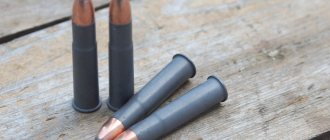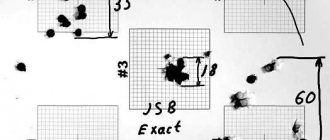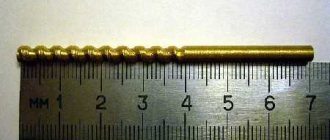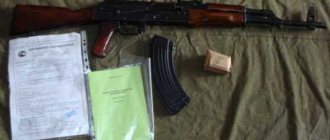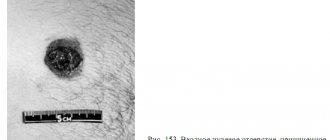On gas pressure and initial velocity of projectiles
photo: Fotolia.com
During prolonged shots, the shot falls to the ground several tens of meters from the muzzle.
In case of failure, the projectile remains in the case or gets stuck in the barrel. If you do not pay attention to this, load the gun again and shoot, the barrel will in most cases be torn.
On the contrary, with very rapid combustion of the charge and a rapid increase in pressure, both the barrel and the box are destroyed before the projectile has time to move.
The art of loading cartridges is to give the projectile, the mass of which corresponds to the caliber and type of gun, an initial speed of the order of 360-380 m/sec, while maintaining the gas pressure within acceptable limits. This is achieved by strict adherence to the recommendations and recipes established by the manufacturer.
Unfortunately, many hunters, and even sports shooters, in the hope of increasing the range of their guns, significantly deviate from the recommended recipes. Moreover, in some cases the maximum pressure reaches a critical level and becomes dangerous not only for the gun, but also for the shooter himself.
Particularly dangerous are individual shots in which the maximum pressure is significantly higher than the average value for a given series of cartridges.
The dependences of pressures and velocities given below on the quality of ammunition and the recipe for loading cartridges were borrowed mainly from the famous French researcher of the combat of hunting rifles, General Journet.
Read the material “How to choose the right gunpowder: Sokol or Sunar”
Capsules of the same pariah produce flames of varying intensity, as a result of which pressure fluctuations with pyroxylin powders reach 50-100 kg/cm2. At the same time, initial speeds with stronger primers increase by only 15-30 m/sec. With smoke powders, which ignite much more easily than smokeless ones, pressures vary within 3-5 kg/cm2, and initial velocities within 2-4 m/sec.
If the bottom of the case has a conical or hemispherical shape, the flame of the primer covers the powder charge more fully than with a flat shape. If in the first case from 5 to 10% of the powder grains remain unignited, then in the second - from 15 to 20%. As a result, with a hemispherical shape of the bottom, the pressure with the same weights of gunpowder increases by 20-30 kg/cm2, and the initial shot velocity increases by 10-15 m/sec.
Sleeves, the outer diameter of which is only 0.1 mm less than normal for a given chamber, reduce the pressure by 20-30 kg/cm2, and the initial speed by 6-10 m/sec. The use of long cartridge cases - 70 or 76 mm long in 65 mm chambers - depending on the length of the transition cone, can increase the pressure by 80-100 kg/cm2.
| photo: Fotolia.com |
On the contrary, shooting short cartridges with long chambers does not pose any danger. Moreover, some guns with long chambers and short cartridges give a more consistent fire (Lampel, 1940).
A change in the charge weight by 0.1 g causes a change in pressure with smokeless powders by 25-40 kg/cm2, and with smoky powders by 3-10 kg/cm2. In this case, the initial speeds change accordingly within the limits of 10-20 m/sec and 3-7 m/sec.
The temperature of the powder charge before firing has a significant influence on the pressure and initial velocity. A change in temperature by 20°C leads to a change in pressure by 50-100 kg/cm2 and initial projectile velocities by 10-15 m/sec.
Read the material “Barrel bore and muzzle device: let’s dispel the controversy”
Therefore, in winter, or more precisely, during severe frosts, the weights of pyroxylin powders can be increased by 0.1 and even 0.2 g compared to the weights for early autumn. Although the temperature does not affect black powder as much, for winter hunting the charges are increased by 0.5 g.
Compressing smokeless powders with wads by more than 6-10 kg leads to an increase in pressure, and with loose, weakly gelatinized varieties, the increase in pressure can even reach 200 kg/cm2. The initial speeds increase by only 10-20 m/sec. Black powder is indifferent to compression with wads, but hammering the wad with a hammer, as our great-grandfathers did, should not be done.
Spacers placed on the powder under the felt wad also affect both pressure and muzzle velocity. In the complete absence of a gasket and with a felt wad, the pressure drops by more than 100 kg/cm2 and the speeds decrease.
In contrast, as the thickness and stiffness of the gasket increases, both pressure and initial velocity increase. The introduction of a sealing plastic gasket on the powder can increase the pressure of smokeless powder by 80-100 kg/cm2. Therefore, when using such cup pads, the charges should be reduced by 0.2 g.
Powder wads made of dense and elastic materials, for example, sole leather or rubber, can increase the maximum pressure above normal by 300-500 kg/cm2, while the initial speed increases only by 20-30 m/sec.
A noticeable increase in pressure is also caused by felt wads that are thickened not by 1-2 mm, but to the full depth. The heavier the powder wad, the higher the pressure and the lower the initial speed and, conversely, the lighter the wad, the lower the pressure and the higher the speed of the projectile.
Powder wads made from cork and wood fiber reduce pressure and muzzle velocities. Cup wads made of cardboard, consisting of two halves put on one another, according to Cherkai, increase the pressure with Sokol gunpowder by 200-300 kg/cm2.
Since with black powder and the same wads the pressure remained normal, one can think that the pressure surges noted by Cherkai were not caused by the wads, but by something else, perhaps compression of the charge. The English researcher Burrard also tested such wads, with various types of smokeless powders, and came to the conclusion that they did not significantly increase pressure.
| photo: Fotolia.com |
An increase or decrease in the shot weight by 1 g entails a pressure change in the range of 15-30 kg/cm2 with pyroxylin powders. With black powder, the change in pressure is much less pronounced. As for the initial velocities, when the projectile mass increases by 1 g, they decrease by 4-7 m/sec, both with smokeless and smoky powders.
Read the material “How to make a high-quality cartridge yourself”
The maximum pressure depends primarily on the magnitude of the boost pressure, and this latter depends on the resistance of the sealed cartridge case neck. [1] remains over the shot wad-pad , then the boost pressure will remain normal.
Naturally, with plastic sleeves, the same 5 mm of rolled barrel will create significantly greater resistance. When pressing the barrel using the “star” method, more free barrel should remain above the projectile, and the forcing pressure increases by 15-20%.
With greatly reduced shot shells (for example, if the gun has a small mass for its caliber), the normal resistance of the muzzle may be insufficient to create the required boost pressure.
As a result, the sharpness of the battle will be unsatisfactory. In such cases, deep rolling of the case neck can increase the maximum pressure by 100-150 kg/cm2 and increase the initial speed by 40-50 m/sec (Fontenot).
The reader might have noticed that very often a sharp jump in maximum pressure is accompanied by a slight increase in initial speed. This happens due to the fact that the average pressure along the channel changes very little.
In carefully and wisely loaded cartridges, all of the above factors are random. In other words, you cannot predict what combination they will form with each shot. However, in most cases, some factors contribute to an increase in pressure and velocity, while others - a decrease.
Read the material “On the difficult issue of obturation”
As a result, the conditions of the shot seem to be balanced, due to which the ballistic indicators remain within the specified limits.
The design features of the gun itself also influence the maximum pressure of powder gases. Thus, the strength of the flame of the igniter capsule depends on the force of impact of the striker and the shape of its “sting”. When the chamber diameter decreases by 0.1 mm, the pressure increases by 20-30 kg/cm2. The length of the transition cone also affects.
[1] In England, it is customary to leave 6 mm of free neck for rolling.
Kirill Martino August 18, 2022 at 05:26 pm
Operating principles of automatic small arms
In automatic weapons, all operations associated with reloading: sending a cartridge into the chamber, closing the bore, unlocking the bolt after firing, extracting the spent cartridge case and removing it are carried out using the energy of the powder gases. Therefore, the design of the automation engine largely determines the design of automatic weapons as a whole, since the engine converts the initial type of energy into mechanical energy of the actuators. For automatic weapons, the location of the power source in relation to the weapon is of great importance. Based on this feature, two types of automatic weapons can be distinguished: with an external and autonomous power source. Weapons with an external energy source can be successfully used in combination with carriers with sufficient energy reserves. An example is the 20-mm American Vulcan M 61 aircraft guns. The external power source can be electrical, mechanical or other; in certain cases, weapons with an external power source have certain advantages over weapons with gas drives. Nevertheless, automatic weapons with an external energy source have not become widespread due to their main drawback: the lack of autonomy and, as a consequence, versatility. Therefore, engines powered by external energy sources are widely used mainly in aviation automatic weapons as auxiliary ones, serving only to reload the weapon in case of failure (for example, misfire) or to quickly reach the operating mode. As an autonomous source of energy in modern automatic small arms, part of the energy of the powder gases generated in the barrel is most often used, and additional engines are springs, both cocked using the same energy of the powder gases and pre-cocked (magazine springs).
Nevertheless, the appearance of modern automatic weapons in most cases is determined by the type, first of all, of the automatic gas engine. Depending on the principle of operation, there are engines that use recoil energy, that is, the recoil force of powder gases, with the removal of powder gases from the barrel bore and using the reaction of the movement of the bullet on the barrel. Various combinations of these operating principles are also possible. In turn, engines that use recoil force are divided into engines that use the recoil of the bolt, barrel and the entire weapon. Engines that use bolt recoil can be blowback, semi-blowback, delayed blowback, or blowback. Engines using recoil can be either long or short stroke. Special gas engines with removal of powder gases through a gas outlet hole in the barrel wall, depending on the location of the selection of powder gases, can be chamber, side and muzzle. Gas engines can also differ in their operating principle: piston and jet. And here it is advisable to consider the main automation systems. Automatic weapon systems with inertial locking, also known as blowback and blowback systems, are the simplest in design. This is due to the fact that these systems are the only ones in which there is no rigid coupling between the barrel and the bolt when fired. In models of automatic weapons using the recoil of a free bolt, the bolt during the shot remains not engaged with the barrel or receiver (bolt) box, but is only pressed against them by the force of the return spring. At the moment of firing, under the influence of powder gases at the bottom of the cartridge case, the bolt moves backward, compressing the return spring. Moreover, the movement of the shutter begins simultaneously with the movement of the bullet. After the bullet has ejected, the bolt continues to move backward due to kinetic energy and removes the cartridge case from the barrel. From the rearmost position, the bolt is sent forward by the force of the return spring and sends the next cartridge from the magazine into the chamber. The operation of this type of automation is significantly influenced by the mass of the bolt and the friction force of the cartridge case on the chamber, which arises as a result of the fact that the pressure of the powder gases presses the cartridge case against the walls of the chamber. Since the movement of the cartridge case from the chamber begins immediately at the moment of ignition of the charge and is slowed down only by the mass of the bolt (hence the term “inertial locking”), these systems have a large mass of moving parts and are designed to use short cylindrical pistol cases with a relatively small mass of powder charge. The use of a long or conical sleeve can lead to rupture of the latter due to the fact that the rear part of the sleeve moves with the bolt, and the front is in a state of tension with the chamber due to the high pressure of the powder gases in the barrel bore. Numerous attempts to get rid of this drawback, for example, the use of lubricated chambers, special longitudinal grooves in them (the so-called Reveli grooves), ignition of the charge when the moving parts do not reach the extreme forward position (bolt rollout), are not widely used. Therefore, inertial locking systems are used mainly in pistols and submachine guns, i.e. in such systems where pistol cartridges with a short cylindrical sleeve are used: domestic Makarov (PM) and Stechkin (APS) pistols, Degtyarev (PPD), Shpagin (PPSh) and Sudaev (PPS) submachine guns, American M3A1 and Ingram M 10, Israeli Uzi, Italian Beretta M 12, etc. A significant positive quality of this type of automation is the simplicity of the design of such weapons. If the bolt is engaged with the barrel during a shot and their disengagement occurs under the influence of the pressure of the powder gases on the bottom of the cartridge case, then such a bolt is called semi-free. On this principle, for example, the automation of the American Thompson M 1928 and Reising M 50 submachine guns is based. In automatic small arms using an automatic system with a semi-blowback, the bolt also begins to move back along with the cartridge case with the beginning of the development of powder pressure gases in the barrel, however, the release of the bolt is inhibited by the locking mechanism due to the action of large friction forces on the elements of the mechanism and due to the accelerated movement of individual parts associated with the bolt. Braking the bolt during its self-unlocking period significantly reduces the kinetic energy of the bolt, allowing the use of more powerful cartridges without greatly increasing the mass of the bolt. The operation of automatic systems with a semi-blowback after self-unlocking of the shutter is not fundamentally different from the operation of automation with a blowback. However, a significant disadvantage of this type of automation is the dependence of its operation on friction forces and, consequently, on the state of the working surfaces of the locking mechanism, which leads to the unreliability of the mechanisms. Varieties of automatics with a semi-blowback differ mainly in the design of the locking mechanisms and methods of braking the shutter. Currently, the semi-blowback has become quite widespread in automatic small arms. In particular, the most successful semi-blowback design is considered to be the locking mechanism with a roller accelerator in the West German G.3 assault rifle. The pressure of the powder gases, acting through the bottom of the cartridge case on the bolt, causes the locking mechanism to move backward. Under the influence of the bevels on the receiver, the rollers are wedged between the bolt and its frame, causing the latter to move with acceleration relative to the bolt. This design is very simple. In addition, the low weight of the shutter and the fairly heavy frame make it possible to reduce the speed of movement of automation parts and reduce shock loads when opening and closing the shutter. But at the same time, it should be noted that the use of a semi-blowback with a fairly powerful 7.62x51 NATO rifle cartridge required the manufacture of Revelli grooves in the muzzle of the chamber. In addition to the simplicity of the device and a fixed barrel, weapons with blowback and semi-blowback bolts have good accuracy of fire, which with a single fire approaches the accuracy of non-automatic weapons.
Another effective way to reduce recoil energy in a blowback weapon while generally reducing the mass of the bolt itself is the use of systems with the bolt being rolled out (i.e., with preliminary breaking of the primer). In this system, the firing process begins even before the bolt reaches its extreme forward position. In this case, the main part of the recoil impulse is spent on stopping the moving parts and only the remaining part is spent on their rollback. When the speeds of roll-up and rollback are equal in the extreme forward position, the rollback energy is reduced by four times compared to a bolt of the same mass that is stationary at the start of the shot. In principle, recoil systems can be implemented in any weapon design where recoil energy is used for automation. However, there are no real designs of such weapons, since designers have so far failed to achieve stability in their operation due to the variation in the ignition time of the charge in the cartridges. Systems using recoil energy from a moving barrel to drive automation are used much more widely than systems with recoil bolts. This is due to the strong adhesion of the barrel and the bolt (locking) during the shot, high reliability and a relatively low level of impact on the installation or on the shooter, since recoil parts of a large mass (barrel with bolt) take away a significant part of the recoil energy during recoil. At the same time, they are relatively complex in design and are sensitive to external firing conditions, such as dust or thickening of the lubricant. The rate of fire of systems with recoil barrels, as a rule, significantly depends on the value of the friction coefficient and can fluctuate within wide limits. Systems using barrel recoil energy are divided into systems with short and long stroke. Systems with a short barrel stroke (with a stroke less than the bolt stroke) are characterized by the fact that the recoil of the barrel is used only to transfer the recoil energy through the accelerator to the heavy driving link of the automation, which is usually the sliding bolt frame. This system has become very widespread in automatic weapons - from pistols to medium-caliber artillery pieces. Among the samples of automatic small arms belonging to these systems, the most famous can be identified: pistols - Soviet Tokarev (TT); German - “Walter” R.38 and “Mauser” K.96; American Colt M1911A1; machine gun "Maxim"; German single machine guns MG.34 and MG.42; American automatic grenade launcher MK 19; Vladimirov's KPV heavy machine gun, etc. In systems with a short barrel stroke, at the moment of firing, under the pressure of powder gases to the bottom of the cartridge case, the bolt and barrel move back. The duration of their joint stroke must be no less than the time the bullet moves along the barrel. After the bullet leaves, the pressure of the powder gases drops, the barrel encounters a limiting stop and stops. The bolt, continuing to move backward, disengages from the barrel and removes the spent cartridge case from the chamber. From the rearmost position, the barrel goes forward - either alone under the action of its spring, or together with the bolt. Most systems with a short barrel stroke use special parts or mechanisms called accelerators (accelerating the movement of the bolt) to vigorously throw the bolt away from the barrel to the rear position. The fact is that the barrel usually has a large mass and therefore receives significant kinetic energy from the powder gases generated during the shot. The shutter has a relatively small mass and a small energy reserve. The barrel makes a short journey and spends its energy mainly on impact in the rear position. The bolt moves over a longer distance, and it needs to have a larger supply of energy to remove the cartridge case, compress the return spring, send a new cartridge into the chamber and close the barrel. The accelerator lever, at the moment the bolt disengages from the barrel, pushes the bolt, accelerating its movement back. Thus, the accelerator redistributes the kinetic energy of the moving parts - it takes part of the energy from the barrel and transfers it to the bolt, while the speed of the bolt increases, and the speed of the barrel slows down. At the same time, in some automatic weapon systems with a relatively light barrel, the automatic weapon may not have an accelerating mechanism (for example, the Soviet TT pistol). Automation, based on the principle of using the recoil of the barrel during its short stroke, does not have an accelerating mechanism even if the bolt is provided with a constant kinematic connection with the barrel. In this case, the barrel and bolt simultaneously come to the extreme forward and extreme rear positions. It is also necessary to mention that due to the energy of the shutter movement, as a rule, most of the reloading operations are performed. In a number of cases, for these purposes, mainly to move the belt with cartridges and feed the next cartridge into the receiver, the recoil energy of the barrel is also used. Automation, the operation of which is based on the use of the recoil energy of the barrel during its short stroke, is widely used in modern automatic weapons, as it provides good reliability of action at a fairly high rate of fire and a small recoil effect on the machine, installation or shoulder of the shooter without the use of special shock absorbers. This principle of automatic operation is especially widely used for heavy machine guns, heavy machine guns and automatic cannons. As for the system with recoil of the barrel with a long stroke (longer than the bolt stroke), it has limited use due to the low rate of fire. This system is characterized by the fact that the barrel itself plays the role of the leading element of the automation. All operations for loading weapons are carried out in a certain sequence and separated by time. In addition, the rollback and rollback of a heavy barrel occurs, as a rule, at low speeds. Automatic weapons with such automation usually have a low rate of fire and have a large dispersion when firing, since the movement of massive parts and their impacts in the front and rear positions cause significant vibrations of the weapon. In military weapons, only one example is known - the French Shosha M 1915 light machine gun with a very low rate of fire - 240 rounds/min. Moving a long and heavy barrel made it necessary to reliably guide it in bulky and heavy guides, which increased the weight of the weapon. Therefore, these shortcomings have practically eliminated the use of the classical design with a long barrel stroke in modern military weapons. However, the advantages of this scheme include the possibility of a late start to eject the cartridge case - after the end of the aftereffect period, when the pressure in the barrel bore has approached atmospheric pressure. The cartridge case is extracted with minimal effort. This advantage has ensured the widespread use of the long-stroke design in smooth-bore automatic hunting weapons, which widely use fragile paper (cardboard) cartridges. Systems with the removal of powder gases through a side hole in the barrel are the most common among all automatic weapon schemes, both small arms and artillery. The operating principle of such systems is characterized by locking the barrel bore for the entire intra-ballistic period, high reliability, less stringent requirements for the manufacturing accuracy of the main components and parts compared to systems using barrel recoil, and low sensitivity to shooting conditions. Such weapons have a special gas chamber, usually located in the front part of the barrel, into which powder gases enter through a gas outlet hole in the barrel bore after the bullet passes through this hole. At the same time, the removal of powder gases is characterized by a high level of impact (recoil) on the installation (for guns) or on the shooter (for individual small arms). In modern automatic weapons, engines with gas exhaust through a side hole in the barrel have become the most widespread. Lateral gas engines have an energy resource sufficient to obtain a wide range of speeds for the leading link of the automation, ensure its reliable operation and allow the implementation of a wide variety of design options for the weapon as a whole. A specific feature of side-mounted gas engines is the wide ability to regulate the intensity of the action of gases on the piston under various firing conditions (normal conditions, dust, rain, changes in the temperature of cartridges and weapons, etc.). The use of gas regulators increased the reliability of automatic weapons. In automatic weapons using the energy of powder gases discharged through a side hole in the wall of the barrel bore, the movable piston, to which the bolt frame rod or bolt stem is connected, is located in the gas chamber before firing. On the chamber side, the barrel is firmly locked with a bolt. Until the bullet passes through the gas outlet, the weapon parts remain relatively motionless. During a shot, after the bullet passes the gas outlet, part of the powder gases rushes into the gas chamber, puts pressure on the piston and forces it to move back. The movement of the piston is transmitted to the bolt frame. While the bullet is in the barrel, the bolt does not unlock; this is ensured by the free movement of the bolt frame. After the bullet leaves, under the action of powder gases, the bolt frame unlocks the bolt and moves to the rearmost position. This removes the sleeve and compresses the return spring. First, the frame moves under the action of powder gases, and then by inertia. When the bolt frame returns under the action of the return spring to the extreme forward position, the cartridge is sent into the chamber, the barrel is closed and the bolt is locked. Currently, two schemes of systems with removal of powder gases from the barrel are known:
- with a long piston stroke; with a permanent connection between the piston and the bolt frame, in which the piston is rigidly connected to the bolt frame (AK/AKM/AK-74 assault rifles);
- with a short piston stroke; with a non-permanent connection between the piston and the bolt frame, in which the piston is not connected to the bolt frame (SKS self-loading carbine; SVD sniper rifle).
The most common is the first scheme, according to which almost all machine guns and most machine guns and assault rifles are designed.
Where there is a need to load a weapon from a clip, the second scheme is used. In this case, the piston makes a slight movement, imparting the necessary kinetic energy to the bolt frame through the pusher and returning to its original position under the action of the pusher spring. The bolt carrier in such systems is part of the bolt and is called the bolt stem. In weapon systems, the automation of which is based on the principle of removal of powder gases, the barrels are usually fixed motionless, however, automatic small arms systems are known in which the removal of powder gases with a movable barrel is used for automatic operation. The automation of the Czechoslovak machine guns ZB-53 and ZB-60 works according to this scheme. When the automatic operation of the ZB-53 machine gun is operating, the barrel, moving back, does not linger in the rear position and returns regardless of the movement of the bolt. When the ZB-60 machine gun is operated automatically, the barrel is held in the rear position by a special latch and moves forward together with the bolt after the cartridge is chambered and the bolt reaches the barrel. This system provides the ability to roll out the barrel. As design variations, we can point to some foreign weapon systems in which the rod moves forward under the influence of powder gases: the French Saint-Etienne M 1907 machine gun or swings relative to the axis (the American Colt M 1895 machine gun. These systems, due to the row significant deficiencies in the operation of automatic weapons are not currently used, and their design features are practically not used in new types of weapons.Automatic small arms often suffer from instability of the aiming line when firing and require the installation of various compensators to reduce the “bouncing” of the weapon and the fulfillment of strict requirements for the alignment of the weapon , installation of rate of fire limiters and some other technical measures.However, automation, the operation of which is based on the principle of removal of powder gases into the gas chamber, provides good reliability of operation and allows you to obtain a high rate of fire with a fairly simple design of the entire weapon with the ability to adjust the intensity of the impact of gases on the moving system. The positive qualities of this type of automation have determined its widespread use in both domestic and foreign models of automatic weapons. Therefore, systems with the removal of powder gases, especially systems with a gas exhaust engine using a piston, currently make up, according to the most conservative estimates, 60-70% of all types of automatic weapons in service with the armies of the world. For example, Soviet design systems M.T. Kalashnikov - AKM, AK-74, RPK and PK; American M16 rifle and single M60 machine gun; German assault rifle G.36; Italian Beretta BM59; Belgian assault rifle FN FAL; Austrian assault rifle AUG; the English light machine gun "Bren" L4A4 and the Belgian light machine gun "Minimi", as well as many other systems for various purposes. The given types of principles of operation of automatic small arms do not exhaust the variety of principles that were used in the creation of automatic weapons and are currently of only historical interest. As for other principles of using the energy of a shot (gas removal through muzzle devices or the bottom of the cartridge case; systems that use the force of cutting a bullet into rifling; a system with the recoil of a weapon in general and others), they are practically not widespread and are known either as experimental or small-scale samples, or from patent information. In conclusion, it should be noted that it is possible to use several automation engines at once in one system. We are talking about mixed type systems, i.e. who use av at work
